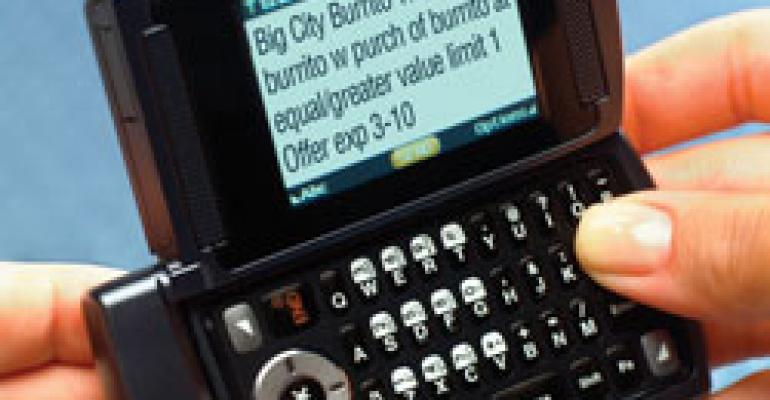With the advent of smart-phone apps, enhanced mobile websites and scannable 2-D bar codes, marketers can easily get overwhelmed trying to keep up. But restaurants don’t always have to chase the next big thing in mobile marketing to succeed, operators and experts say.
Many restaurateurs praise the simplicity and high return on investment of text coupons, the understated workhorse of mobile advertising. Mobile experts note that text messaging and SMS already reach a broad base of consumers, with plenty of room for growth.
Consider the case of Scotty P’s Hamburgers. The Dallas-based operator of seven casual-dining restaurants in Texas has been using a text message platform run by mobile marketer Call-Em-All for the past month and already reports redemption rates of 12 percent.
The burger brand’s founder and president, Scott Pontikes, said advertising options in the mobile channel beyond text coupons would require too big an investment in time and money.
“The smart-phone apps and even mobile ordering would be cost-prohibitive for us,” he said. “Texting is low-tech, simple and quick, and the response rate is probably three times what it is for e-mailing. Our e-mail program has a larger list, but we’ve seen a 12-percent adoption rate on 25-word messages that take a few minutes to prepare.”
Pontikes said text message offers valid for a three-hour window during a typically slow Monday lunch daypart have produced incremental revenue of about $1,000 a day. When subtracting the food cost of discounted items and comparing the revenue to the price of the offer, which he said was 7.5 cents per text in a batch of 500, Pontikes calculates his ROI at more than 1,600 percent.
That lift in sales is in addition to the time and labor saved not developing creative for a direct-mail piece or a graphics-laden e-mail, since the offering being pushed is all text.
“E-mail’s response rate is about 4 percent, and we don’t do direct mail because the rate’s so ridiculous and the development’s outrageous,” Pontikes said. “With this, the overhead is 7.5 cents on a text message and five minutes of my time. If I can grow my list like I want to and get this kind of response rate, who needs a marketing department?”
Text messaging also allows restaurants to reach more customers, said Bryce Marshall, director of strategic services for Akron, Ohio-based direct digital marketing firm Knotice. Of the 300 million mobile-phone subscribers in the United States, he said, only a small percentage of people have smart phones and data plans for running apps and Web surfing, but nearly everyone can receive a text message.
“Short message service, or SMS, doesn’t have somebody like Apple spending large amounts of money to market it, but from a reach component, it can interact with virtually every consumer,” Marshall said. “Broad-based marketers want to talk to everybody. You end up spending a lot more money to move down that mobile adoption funnel [to people with smart phones].”
He added that adoption of text messaging has migrated up into the baby boomer demographic as well, with more than half of those consumers comfortable with using SMS and texting.
Knotice works with several brands in the retail sector and counts Texas Roadhouse as a restaurant client for its text-marketing platform.
Another mobile marketer involved in the restaurant industry is Money Mailer, a subsidiary of restaurant industry investor Roark Capital Group and a provider of text-marketing platforms to franchise operators. Money Mailer’s chief operating officer, Steven Gray, said text message campaigns average redemptions in the 10 percent to 15 percent range, which is higher than averages for direct mail and e-mail.
Money Mailer recently released a new platform, Mozart, that integrates a restaurant brand’s text messaging with e-mail marketing, direct mail and voice marketing, all tied to a restaurant’s point-of-sale system. Users can access the messaging software from an online dashboard, which also collects data and analytics.
But many of the firm’s clients report success with simple text messaging.
Joe Marcotte, a franchisee of Oggi’s Pizza in Jolla Vista, Calif., and a Money Mailer user, said the speed at which people open text messages, compared with e-mails, made a mobile-marketing platform a necessary complement to his e-mail and direct-mail efforts.
“The difference between texting and e-mailing is that the client is going to receive the text right away, and an e-mail may not be seen in the time frame it’s needed to be seen,” Marcotte said. “It seems like it’s an effective way to get a push out in real time.”
Another Money Mailer user, Ever Santana of Totowa, N.J.-based Fabris Companies, agrees that simple texting is the fastest way to promote his restaurants, which include two IHOP units, 17 Dunkin’ Donuts locations and one Sonic Drive-In. Santana’s company began using a text-messaging platform for promoting events at his IHOP franchises, rather than pushing coupons, and soon found the messaging spreading virally beyond the original users who had opted in.
“The good thing we found was that people would forward the messages, and we had more redemptions than we had people enrolled,” Santana said.
He also was pleasantly surprised at the diverse group of people drawn to the stores by text messages, getting a mix of not only young diners who text a lot, but also older customers who had received the forwarded message.
“In today’s economy, you have to have everything and seek every possible advantage,” Santana said. “I found that I needed another avenue to communicate to our customer base, because not everybody has a Blackberry and not everybody’s constantly behind a computer.”
Contact Mark Brandau at [email protected].

